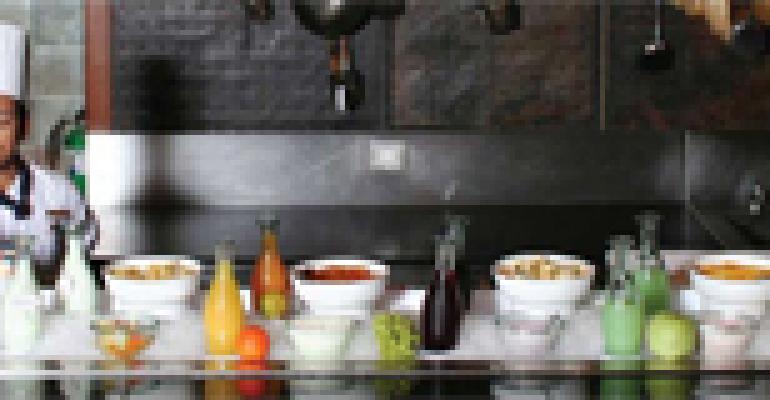
It's the section of the globe bursting with coconut-crusted this, ginger-spiced that and fish eyeballs that stare up from the serving platter. Who isn't captivated by what happens on the plate in the Asia Pacific region?
American menu makers long for more insight into all that's a day's flight away in such regions as Hong Kong, Taiwan, Japan, India, Russia, Korea, Malaysia, Singapore, Thailand, Vietnam and the Philippines. Even Australia and New Zealand are a part of the Asia Pacific region.
And, just what is going on in the food world over there? Do Asian chefs wistfully eye the American plate for trends they can emulate?
No. Not according to one Marriott official.
Last fall, Marriott International conducted its third annual Asia Pacific Culinary Workshop for Marriott chefs, held at Singapore's renowned SHATEC (The Singapore International Hotel and Tourism College). Each year, 20 chefs from among the 97 Marriott properties in the Asia Pacific region are invited to the week-long cooking school to brush up on the region's culinary trends and sharpen their kitchen skills. Such locales as China, Australia, India, Korea, Malaysia, Thailand and the Philippines were represented at this most recent workshop.
Christian Abell, Marriott's Asia Pacific regional director of operations based in Hong Kong and organizer of the event, sat down with Restaurant Hospitality at the Singapore Marriott during a break in the action to candidly discuss various culinary trends and thinking/training in its hospitality operations.
Fusion: It's finished in Asia Pacific. “There's Asian, and there's Western, but not fusion. If a dish is Indonesian, keep it that way, as in nasi goreng. Don't create it to be something it is not. Make sure to really cook authentically and simply.”
Culinary models: Asia Pacific locales don't model after the U.S., but everywhere. “We see French trends. The simple, classic French street bistro is back with its rich, intense focus on food with three focal points on the plate.”
Plating style: Architectural cuisine is out. Stacking plate elements have given way to simple, easy-to-eat elements with no more than five components at one time. For example, during one workshop, a chef presented rack of lamb, a Greek salad and lentils. “That's the essence of simple; a protein, a good simple Greek salad and lentils on the side.”
Food safety: Chicken is popular in Asia Pacific, and with North Asian bird flu fresh in everyone's mind, food safety is a bigger concern in that part of the world. “We analyze our food more. SARS and bird flu have been huge issues for us. It's hard to promote fresh poultry with our Asian flu history.”
Organics: It's one of the biggest food trends in Asia Pacific. Where buying locally has superseded organics in the U.S., Asia Pacific is focused on organics with not much attention given to buying locally.

Food for health: The food in Asia Pacific tends to be healthy, but it's happening more subconsciously than from focusing on waistlines. “Dressings are lighter. Mayonnaise is falling away. Today in a workshop session, a guy used lemon, quality olive oil and salt and pepper for a dressing. It was perfect. People are cooking lighter and exercising more. It's to live a better life, and this falls into it,” Abell said.
Flavor profiles: Chefs study for ways to extract the most precise flavor. For example, garlic boiled in a cup of water tastes different, depending on if the garlic is sliced, ground or finely chopped. Lemon combined with salt yields a more concentrated lemon flavor. “We're aware of different ways to use better flavor profiling.”
Cooking simply: With labor costs going up and difficulty in finding quality chefs for hotel restaurants, cooking simply with the fewest number of ingredients is a must. The goal is to deliver simple, fresh, chef-crafted food with perfect execution and technique. Simple means that the food and presentation are familiar, not overly done or manipulated. “It's ingredient based. It's real food, not processed, and it's seasonal. It has a clean flavor and has a limited number of components. The idea is less is more.” The food is the star. It uses color and texture contrasts.





